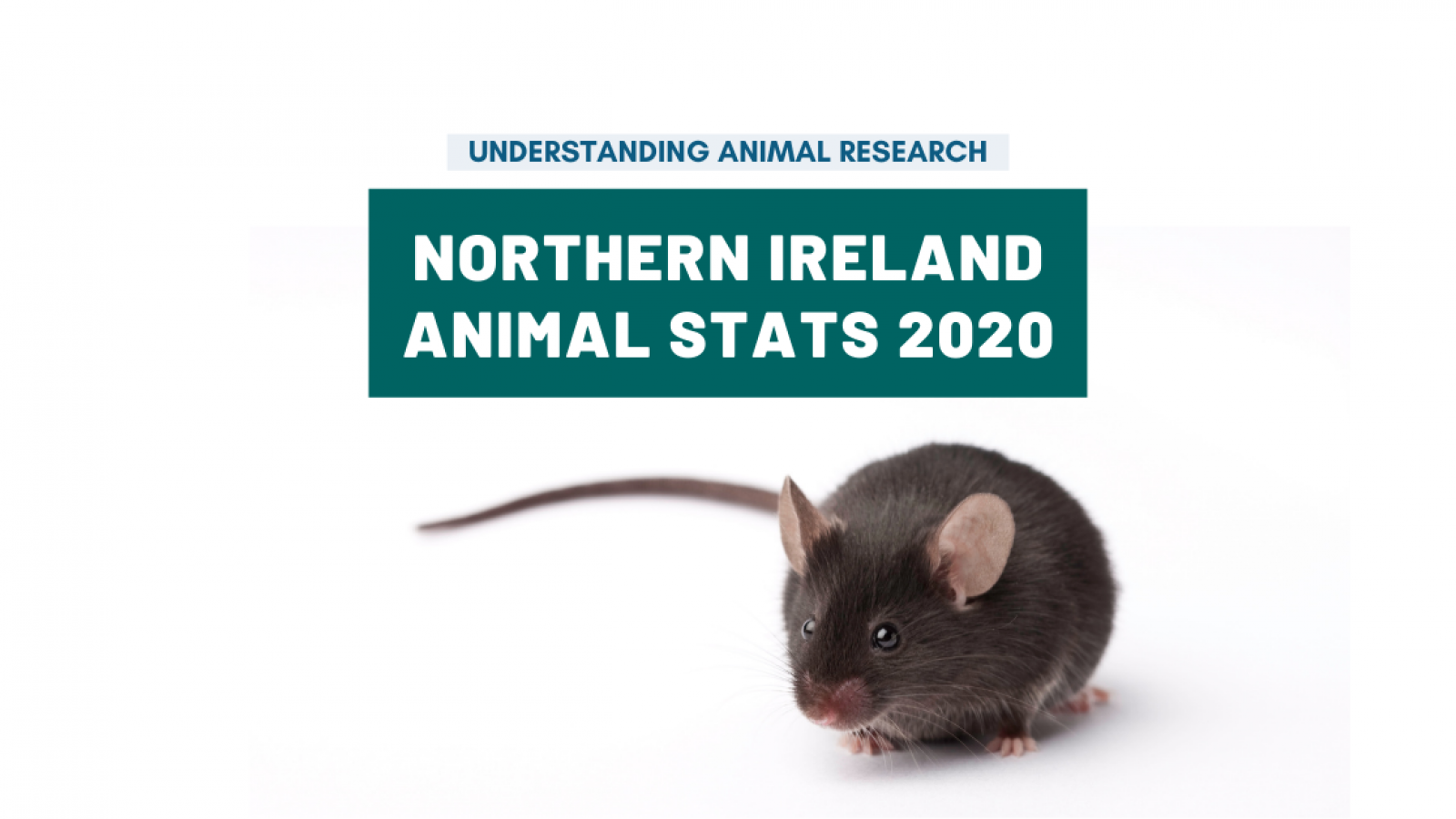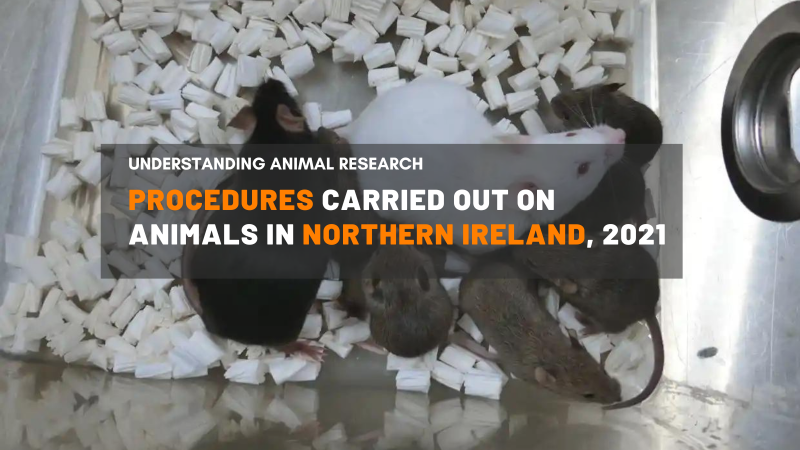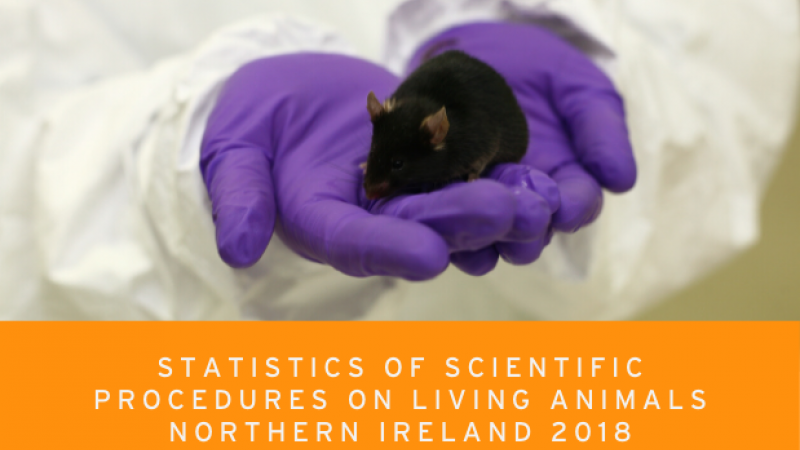Latest figures show a decrease in animals used in research in Northern Ireland in 2020
-
Number of procedures on animals in 2020 has decreased by 19.4% to 22,707
-
Large decrease due to various Covid-19 national lockdowns
-
Lowest number of procedures since 2016
-
Mice, fish, rats, and birds account for over 92% of all procedures
-
Cats and dogs account for 0.8% of all procedures
Today (Thursday, 4 November 2021) the Department of Health in Northern Ireland has released its annual statistics on the number of animals used in scientific, medical and veterinary research in 2020. The figures show that 22,707 procedures were carried out in Northern Ireland in 2020, 19.4% less than in 2019.
Over 92% of the procedures were carried out in mice, fish, rats, and birds, whereas cats and dogs accounted for 0.8% of all procedures in 2020.
While mice are the most common species used (80% of the total), pigs, sheep, and cattle together account for 7% of research, reflecting the large amount of agricultural research conducted in Northern Ireland.
In 2020, England, Scotland and Wales carried out 2,883,310 procedures on animals, of which 92% were on mice, fish and rats. The 22,707 procedures carried out in Northern Ireland represent approximately 0.8% of animal research across the UK.
What is a procedure?
Any procedure applied to a protected animal for an experimental or other scientific purpose, or for an educational purpose, that may have the effect of causing an animal pain, suffering, distress or lasting harm equivalent to, or higher than, that caused by the introduction of a needle in accordance with good veterinary practice.
How many animals are used?
The number of procedures carried out in a year does not equal the number of animals that have been used in procedures that year. This is because some animals may be used more than once i.e. ‘re-used’, in certain circumstances. These instances are counted as separate, additional, procedures. As a result, the number of procedures is usually slightly higher than the number of animals used.
Specially protected species
Specially protected species refers to cats, dogs, horses, and non-human primates - they are subject to additional protection under Section 5C of the Animal (Scientific Procedures) Act 1986. This means these species can only be used when no other species is suitable. These species were used in 0.8% of all procedures. No primates have been used in experiments in Northern Ireland in over a decade.
Number of Animal Procedures in Northern Ireland in 2020
| Species | Experimental Procedures | % | Procedures for the Creation & Breeding of Genetically Altered Animals | % | Total Procedures (2020) | % | % change from 2019 |
| Mice | 11,182 | 71.09% | 6,913 | 99.07% | 18,095 | 79.69% | -22.94% |
| Rats | 328 | 2.09% | 65 | 0.93% | 393 | 1.73% | -57.28% |
| Cats | 56 | 0.36% | 0 | 0.00% | 56 | 0.25% | 166.67% |
| Dogs | 131 | 0.83% | 0 | 0.00% | 131 | 0.58% | 367.86% |
| Domestic fowl | 981 | 6.24% | 0 | 0.00% | 981 | 4.32% | 20.52% |
| Pig | 481 | 3.06% | 0 | 0.00% | 481 | 2.12% | 69.96% |
| Sheep | 653 | 4.15% | 0 | 0.00% | 653 | 2.88% | -11.28% |
| Cattle | 469 | 2.98% | 0 | 0.00% | 469 | 2.07% | -42.80% |
| Fish | 1,362 | 8.66% | 0 | 0.00% | 1,362 | 6.00% | 38.56% |
| Other animals | 86 | 0.55% | 0 | 0.00% | 86 | 0.38% | 1.18% |
| Total | 15,729 | 69.27% | 6,978 | 30.73% | 22,707 | 100.00% | -19.40% |
Purpose of procedure
Experimental procedures decreased by 29% compared to the previous year, while procedures related to the creation and breeding of genetically altered animals increased by 17%.
Procedures for creation and breeding involve the breeding of animals whose genes have mutated or have been modified. These animals are used to produce genetically altered offspring for use in experimental procedures but are not themselves used in experimental procedures.
31% (6,978) of all procedures were for the creation or breeding of genetically altered (GA) animals. Of these 6,978 procedures:
-
97% were for the purpose of maintenance of established lines of genetically altered animals
-
3% were for the creation of new lines of genetically altered animals
Experimental procedures involve using animals in scientific studies for purposes such as basic research and the development of treatments, safety testing of pharmaceuticals and other substances, education, specific surgical training and education, environmental research and species protection.
69% (15,729) of all procedures were for experimental purposes. This includes basic research, which expands our knowledge of living organisms and the environment; applied research, which addresses the prevention of disease and development of treatments; and regulatory research, which includes studies aimed at ensuring product safety and the effectiveness of pharmaceuticals. Of these 15,729 procedures:
-
44% were for applied research
-
38% were for basic research
-
15% were for the protection of the natural environment
-
3% were for regulatory research
Severity of Animal Procedures in Northern Ireland in 2020
| Severity | Experimental Procedures | % | Procedures for the Creation & Breeding of Genetically Altered Animals | % | Total Procedures (2020) | % | Change from 2019 |
| Sub threshold | 1,751 | 11.13% | 4,342 | 62.22% | 6,093 | 26.83% | ↑ |
| Non-recovery | 147 | 0.93% | 2 | 0.03% | 149 | 0.66% | ↓ |
| Mild | 5,246 | 33.35% | 2,070 | 29.66% | 7,316 | 32.22% | ↓ |
| Moderate | 8,403 | 53.42% | 390 | 5.59% | 8,793 | 38.72% | ↓ |
| Severe | 182 | 1.16% | 174 | 2.49% | 356 | 1.57% | ↓ |
| Total | 15,729 | 6,978 | 22,707 |
Severity assessments measure the harm experienced by an animal during a procedure. A procedure can be as mild as an injection, or as severe as an organ transplant. Severity assessments reflect the peak severity of the entire procedure and are classified into five different categories:
Sub-threshold: When a procedure did not cause suffering above the threshold for regulation, i.e. it was less than the level of pain, suffering, distress or lasting harm that is caused by inserting a hypodermic needle according to good veterinary practice.
Non-recovery: When the entire procedure takes place under general anaesthetic and the animal is humanely killed before waking up.
Mild: Any pain or suffering experienced was only slight or transitory and minor so that the animal returns to its normal state within a short period of time. For example, the equivalent of an injection or having a blood sample taken.
Moderate: The procedure caused a significant and easily detectable disturbance to an animal’s normal state, but this was not life-threatening. For example, surgery carried out under general anaesthesia followed by painkillers during recovery.
Severe: The procedure caused a major departure from the animal’s usual state of health and well-being. This would usually include long-term disease processes where assistance with normal activities such as feeding and drinking were required, or where significant deficits in behaviours/activities persist. Animals found dead are commonly classified as severe as pre-mortality suffering often cannot be assessed. Most severe procedures arise in regulatory testing such as evaluation of toxicity of drugs.
Sub-threshold and mild procedures account for 59% of all procedures in 2020.
Animal research and Covid-19
In 2020, animal research has been essential for developing lifesaving vaccines and treatments for Covid-19. Ferrets and macaque monkeys were used to test the safety and efficacy of Covid-19 vaccines, including the successful Oxford-AstraZeneca vaccine. Hamsters are being used to develop Covid-19 treatment strategies as they display a more severe form of the disease than ferrets and monkeys. Guinea pigs have also been used in regulatory research to batch-test vaccine potency.
Despite all this research to develop vaccines and treatments for Covid-19, the majority of UK research facilities carried out significantly less research than usual, due to the various national lockdowns. Therefore, the 2020 figures cannot be reasonably compared with previous statistics.
Northern Ireland regulates its animal research and compiles its statistics separately from the rest of the UK (regulated by the Home Office). Every year, the Department of Health in Northern Ireland produces a detailed report explaining what animals were used in different types of research over the year. The research is carefully regulated under the Animals (Scientific Procedures) Act, 1986.
More details on Northern Irish statistics can be found here: https://www.health-ni.gov.uk/publications/statistics-scientific-procedures-living-animals-northern-ireland
Last edited: 1 November 2022 11:28




